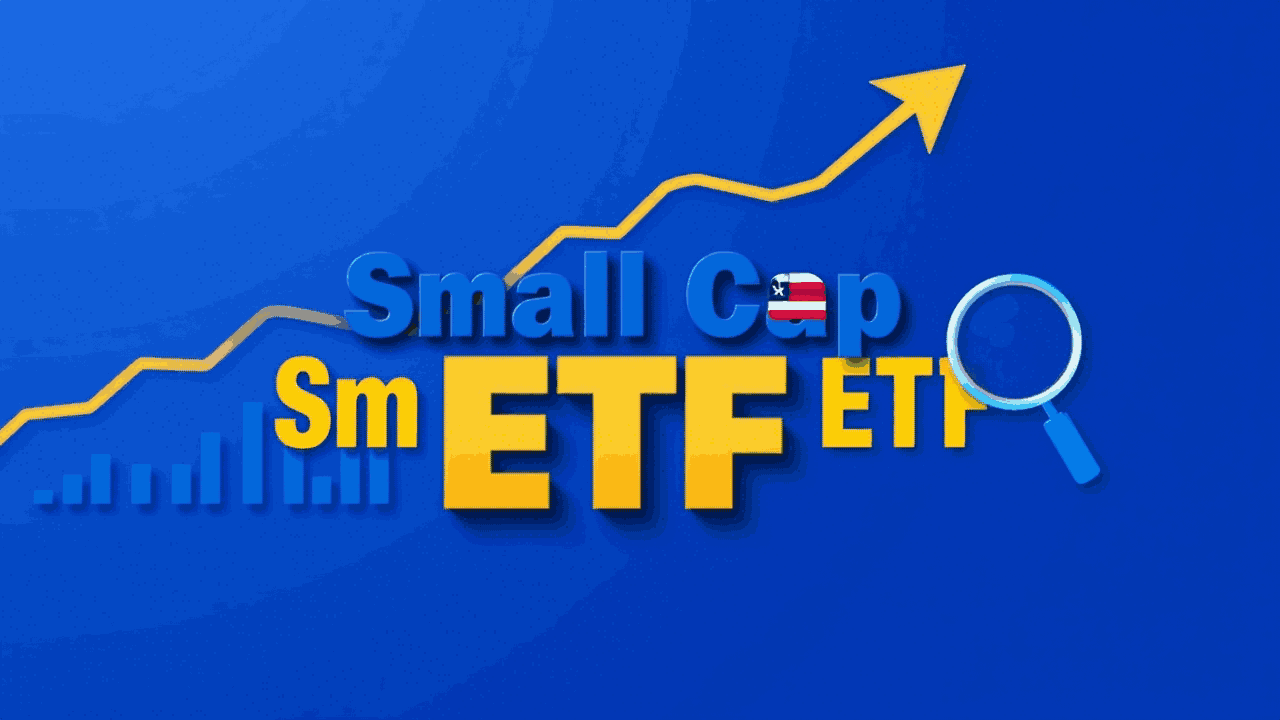Introduction
Are you looking to add a new twist to your investment journey? The “Small Cap ETF” is a powerful tool that lets you invest in small, high-growth US stocks. It is possible to have exposure within companies without taking individual stock risk. In this detailed guide we’ll cover: small-cap ETF fundamentals, top picks for 2025, risk-management strategies, tax considerations, and real-life anecdotes – all woven into a conversational tone that feels like a friendly conversation. Preparation started? Let’s dive in!
Table of Contents

1. What is a small cap ETF?
small cap etf That fund is in the U.S. Invests in the small-cap segment of the stock market – companies with market capitalizations ranging from approximately $300M to $2B. ETFs, i.e. exchange-traded funds, are a basket of shares that you can trade like shares on a stock exchange. When you buy a small-cap ETF, you are taking a stake in several small companies at once, taking advantage of diversification.
Ground level: A small-cap ETF gives you high growth potential without taking a single-stock gamble.
2. Explaining Market Cap Categories
- Big Cap: Market Cap $10B+
- Mid Cap: $2B-$10B
- small hat: $300M-$2B
- Micro Cap: $50M-$300M
These categories are important because each cap segment has a different risk-return profile. Small caps have historically generated higher returns over the long term than large caps, but they also have higher volatility.
3. Benefits of Small Cap ETFs
- High Growth Potential:
- Anecdote: A friend of mine Raj had invested in small cap ETF VB in 2015. His principal increased by approximately 140% in 5 years.
- Anecdote: A friend of mine Raj had invested in small cap ETF VB in 2015. His principal increased by approximately 140% in 5 years.
- Underlying Diversification:
- Hundreds of smaller companies in one ETF – less impact of a single-company failure.
- Hundreds of smaller companies in one ETF – less impact of a single-company failure.
- Low Expense Ratio:
- Typical range: 0.03%-0.20%, much lower than mutual funds.
- Typical range: 0.03%-0.20%, much lower than mutual funds.
- Liquidity and Transparency:
- Real-time pricing, bid-ask spreads transparent.
- Real-time pricing, bid-ask spreads transparent.
- Tax Efficiency:
- The ETF structure minimizes in-kind redemptions and capital gains distributions.
- The ETF structure minimizes in-kind redemptions and capital gains distributions.

4. Main risks and how to reduce them
| type of risk | Description | Mitigation |
| instability | Small caps have greater price volatility | Use Dollar-Cost Averaging, SIP |
| economic sensitivity | Small companies are struggling in the economic recession, returns may suffer. | core-satellite approach |
| liquidity risk | Some small-cap stocks lack liquidity, have wide bid-ask spreads | Choose high volume ETFs |
| tracking error | ETF performance may differ slightly from the index | Select Low Tracking Error ETFs |
tip: Be sure to review the ETF’s fact sheet and prospectus every quarter.
5. Top 5 Small Cap ETFs for 2025
| anchor | etf name | expense ratio | AUM (May 2025) | holdings | index tracked |
| ijr | iShares Core S&P Small-Cap ETF | 0.06% | $75.9b | 600 | S&P SmallCap 600 |
| V.B | Vanguard Small Cap ETF | 0.05% | $16.98b | 1,411 | CRSP US Small Cap |
| S.H.A | Schwab US Small-Cap ETF | 0.04% | $15.95b | 1,718 | Dow Jones US Small-Cap Total Market |
| vbk | Vanguard Small-Cap Growth ETF | 0.07% | $20.3b | 620 | CRSP US Small Cap Growth |
| etc | iShares Russell 2000 ETF | 0.19% | $60.2b | ~2,000 | Russell 2000 |
These ETFs are top choices because of their mix of diversification, liquidity, and cost-efficiency.
6. Performance Comparison Table
(Regardless of annual returns till March 31, 2025)
| etf | 1-year returns | 3-Year Returns (Rs.) | 5-year returns (est.) | Since the establishment (Est.) |
| ijr | 14.2% | 9.8% | 11.3% | 10.5% |
| V.B | 15.0% | 10.1% | 11.5% | 10.8% |
| S.H.A | 14.8% | 9.5% | 11.0% | 10.3% |
| vbk | 18.5% | 12.0% | 13.2% | 12.7% |
| Etcetera | 13.5% | 9.0% | 10.2% | 9.8% |

Analysis: Growth-tilt ETF VBK has delivered some of the most impressive returns in recent years, but has also seen a high expense ratio and volatility.
7. Index Options: S&P vs Russell vs CRSP
- S&P SmallCap 600: Profitability screen, strict listing criteria.
- Russell 2000: Comprehensive coverage also includes non-profits.
- CRSP US Small Cap: Traditional, market-cap weighted.
| Speciality | S&P 600 | Russell 2000 | CRSP US Small Cap |
| profitability screen | Yes | No | No |
| number of components | 600 | ~2,000 | ~1,400 |
| restructuring frequency | Quarterly | every year | Quarterly |
| sector diversity | medium | high | high |
Select S&P 600 If there is a need for a quality-focused small cap. Russell 2000 If maximum width is required.
8. Step-by-Step: How to Invest in India
- Brokerage account held: Zerodha, Fidelity, Schwab, Vanguard-whatever low-cost brokerage.
- ETF Screen Karein: Apply ticker, expense ratio, AUM, tracking error, volume filters.
- Select order type: Market order or limit order – Given a tight bid-ask spread.
- Decide post size later: Portfolio at 5-20%. Risk tolerance based salary.
- Automated Investing: Dollar-cost averaging by setting up SIPs or recurring purchase orders.
- Regular Review: Quarterly or semi-annual ETF fact sheets and portfolio rebalancing.
Pro Tip: Buy on dips – If the small cap market declines, you can take additional exposure to quality ETFs.
9. Portfolio construction and diversification

“Core-Satellite” Strategy Best for a Strong Portfolio:
- Core (60-80%): Broad US Market ETFs (e.g., VTI, SCHB)
- Satellite A (10-20%): Small Cap ETF (IJR, SCHA)
- Satellite B (5-10%): Sector or style bias (VBK for growth; VBV for value)
- International Diversification (5-10%): VXUS for global equities
| component | Example ETF | allotment | Role |
| Core US broad market | VTI | 60% | Stability and market coverage |
| U.S. small cap | ijr | 15% | growth potential |
| Style Inclination (Development) | vbk | 10% | Potential for higher returns |
| international equality | VXUS | 10% | global diversification |
| cash or bond buffer | bnd | 5% | protection from downside |
Key: Maintain risk with discipline and periodic rebalancing (annually or semi-annually).
10. Tax Implications and Cost Analysis
- Dividend Distribution: Qualified vs. Non-Qualified Dividends; Net-effective tax rate 0-23.8%.
- capital gains: Long term vs short term. ETFs typically reduce capital gains through in-kind redemptions.
- Tax-loss harvesting: Sell poor performers at the end of the year, offset capital gains.
- Expense Ratio Effect:
| expense ratio | Final Value After Fees (10 Years, $10k @7% Pre-Fee) |
| 0.04% | $19,400 |
| 0.06% | $19,100 |
| 0.10% | $18,600 |
Illustration: If the expense ratio is 0.06% vs 0.10% that could make a $500 difference on $10k over 10 years.

11. Common Mistakes to Avoid
- Chasing Past Returns: Blind investing on high-return ETFs is risky.
- Ignoring Liquidity: Wide spreads in low-volume ETFs increase costs.
- Over-concentration: There should not be too much bias towards single sector or style.
- Skipping Rebalancing: Flow leads to allocation mismatch.
- Ignoring Tax Effects: Do not ignore capital gains distributions.
Lesson: Patience and a disciplined approach bring lasting success.
13. FAQ
Are small cap ETFs only for aggressive investors?
Even investors with moderate risk appetite can benefit if you follow a disciplined approach, core-satellite strategy and proper allocation.
Which index is better: S&P SmallCap 600 or Russell 2000?
The S&P 600 focuses on quality companies with a profitability screen; The Russell 2000 provides comprehensive coverage, including early-stage unprofitable firms. This will depend on your risk tolerance.
How much should I allocate to small caps in the portfolio?
Typical range 5-20% recommended. Young investors may want to consider a higher level; Retirees are at the bottom.
When to consider an international small cap ETF?
For global diversification; But keep in mind currency risk, geopolitical risk.
How to reinvest dividends in ETFs?
Automatic reinvestment is possible with a Dividend Reinvestment Plan (DRIP).
What is tracking error?
The historical difference in returns of an ETF and its benchmark index – the lower the better.
How to evaluate ETF liquidity?
Determine by looking at the average daily trading volume and bid-ask spread reports; Higher volume and tighter expansion is beneficial.
How does tax-loss harvesting apply to small cap ETFs?
Losses from selling underperforming holdings will be used to offset gains, but wash-sale rules will be followed.
What other costs should be considered beyond the expense ratio?
Bid-ask spread, fund turnover, and brokerage commission (if applicable).
Should small cap ETFs be held in retirement accounts?
Holding dividends and capital gains in tax-deferred accounts (401k, IRA) provide tax deferral benefits.

13. Conclusion and Next Steps
U.S. There are small cap ETFs available to you in the U.S. This is a great way to provide exposure to a dynamic, high-growth segment of the market with built-in diversification, low cost structure and tax efficiency. key findings:
- Research: Analyze expense ratio, AUM, tracking error.
- Diversify: Adopt a core-satellite portfolio strategy.
- Discipline: Follow dollar-cost averaging and periodic rebalancing.
- Tax Management: Understand crop losses, distribution.
Call to action:
- Explore our resources: Check out our beginner’s guide to ETFs and ETF comparison tools.
- Subscribe now: Sign up for our newsletter to receive the latest ETF insights and market updates.
- Start Investing: Open a brokerage account and make your first small cap ETF purchase with confidence.
Your investment journey starts here – making informed decisions and being patient to make big profits from small caps.
ALSO READ
Best Forex Trading Platforms for Beginners in the USA | Ultimate Guide
How to Invest in Africa: Ultimate 2025 Guide for U.S. Investors

